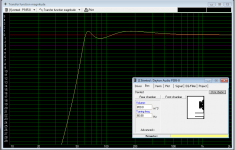I recently finished my second speaker build, but the listening experience and tests with an OmniMic system reveal an unexpected lack of low-end. Given that the drivers are only 3 1/2", I wasn't expecting a lot of bass, but the it had substantially worse frequency response than the driver manufacturer's specs. How did I go wrong?
Design details:
The driver frequency response from the manufacturer is flat until about 100Hz. The calculations I did with Speaker Box Lite estimated a port tuned to about 66Hz would keep the response flat down to about 50Hz.
To my dismay, the finished product seems to start dropping off at ~1kHz. When listening to music, the low end is pretty absent. Kick drums lack body and baselines are hard to pick out. Any help understanding what is going on here would be greatly appreciated!
Design details:
- Two Dayton Audio PS95-8 full range drivers.
- One port that is ~6" long and 2.5" in diameter with a flared end.
- Box has ~650 cubic inches of interior volume after taking drivers and components into account. I calculated the ideal volume as 775 cubic inches, and I may try stuffing the box with some kind of acoustic treatment to "inflate" the perceived volume.
- Uses a Dayton Audio DTA-2 Class D Digital Audio Amplifier Module.
- Two frequency response results I got from measuring the finished product with OmniMic. One is at a higher SPL level.
- The frequency response of the driver, supplied by Dayton.
- The low-end response of the box, as calculated by Speaker Box Lite.
- The finished box to give a sense of the design.
The driver frequency response from the manufacturer is flat until about 100Hz. The calculations I did with Speaker Box Lite estimated a port tuned to about 66Hz would keep the response flat down to about 50Hz.
To my dismay, the finished product seems to start dropping off at ~1kHz. When listening to music, the low end is pretty absent. Kick drums lack body and baselines are hard to pick out. Any help understanding what is going on here would be greatly appreciated!

Attachments
-
 bookshelf snapshot 1.png9.8 KB · Views: 256
bookshelf snapshot 1.png9.8 KB · Views: 256 -
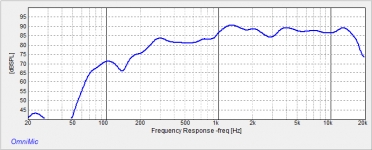 bookshelf snapshot 2.png9.5 KB · Views: 259
bookshelf snapshot 2.png9.5 KB · Views: 259 -
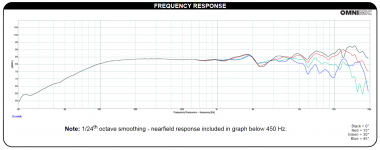 Screenshot_2020-09-01 295-349--dayton-audio-ps95-8-spec-sheet pdf.png142.4 KB · Views: 273
Screenshot_2020-09-01 295-349--dayton-audio-ps95-8-spec-sheet pdf.png142.4 KB · Views: 273 -
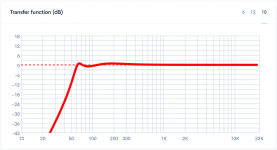 Screenshot_2020-09-01 SpeakerBoxLite Subwoofer box calculator, Sub box calculator.png42.5 KB · Views: 247
Screenshot_2020-09-01 SpeakerBoxLite Subwoofer box calculator, Sub box calculator.png42.5 KB · Views: 247 -
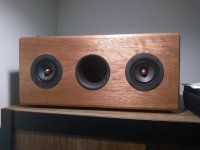 IMG_20200901_214835066.jpg906.8 KB · Views: 366
IMG_20200901_214835066.jpg906.8 KB · Views: 366
Baffle step ?
How far back are you measuring ?
Could be peaking near 1khz if driver is equidistant from 3 baffle edges.
Do you have square internal dimensions ?
Could be a combination of some of theses things.
I had a 3" sounded wonderfull at 6" on open baffle, the further away you got, the less bass and midrange it had.
How far back are you measuring ?
Could be peaking near 1khz if driver is equidistant from 3 baffle edges.
Do you have square internal dimensions ?
Could be a combination of some of theses things.
I had a 3" sounded wonderfull at 6" on open baffle, the further away you got, the less bass and midrange it had.
You will never, ever, obtain a response flat to 50Hz with a 28.3 cm² Sd, 2.5mm Xmax driver (unless you attenuate everything above that!), no matter what the sims predict. Physics precludes it, I'm afraid. A cello only goes down to 65Hz, and look at the size of one of them... Best put them in a sealed enclosure and add a sub if you want bass. This will remove much excursion from these tiny drivers and let them do what they do best - 100Hz and above.
PS. Great place, Oregon - enjoyed working in Eugene in the '80s!
PS. Great place, Oregon - enjoyed working in Eugene in the '80s!
It almost looks like you have a high pass filter in there somehow. Have you sanity checked other speakers with that amp, or other amp with these speakers? Do you have any passive components in your design? I have found parts express does a pretty poor job of labeling capacitors, and some of their capacitors actually measure completely wrong on a meter!
I've been thinking on this, especially bass and distance and cone size.
I notice bass goes deeper in a room, the large the cone is.
An 8" 2-way on floor had some thump till 6' away.
Pair of 12's you get a bit of thump further back.
Double 15's, you get thump 20' away.
I had a 3" that was great close, worse the further you got from it.
Since sound is measured as pressure (spl sound pressure level), there is less air movement the further you get away (harder to move the air). So the further away you get, the harder it is to move the air, but also higher in frequency is also affected.
So low mids seem way too low at 10' from a 3" driver ?
Or it seems you are rolling off at 1khz at 10' ?
idk, kind of rambling / spit balling here...………………..
I notice bass goes deeper in a room, the large the cone is.
An 8" 2-way on floor had some thump till 6' away.
Pair of 12's you get a bit of thump further back.
Double 15's, you get thump 20' away.
I had a 3" that was great close, worse the further you got from it.
Since sound is measured as pressure (spl sound pressure level), there is less air movement the further you get away (harder to move the air). So the further away you get, the harder it is to move the air, but also higher in frequency is also affected.
So low mids seem way too low at 10' from a 3" driver ?
Or it seems you are rolling off at 1khz at 10' ?
idk, kind of rambling / spit balling here...………………..
Last edited:
Have you tried with a a different (higher powered) amp? The little DTA-2 might be in a little over its head.
Perhaps one driver is out of phase?
Test with a AA battery, see that the cone motion for each driver is in the same direction.
Test with a AA battery, see that the cone motion for each driver is in the same direction.
Thanks everybody for the ideas/thoughts! Things I will check when I get some spare time:
More info:
Something I forgot to mention in the first post was that the DTA-2 manual says: "Solder an output capacitor across the speaker terminals in parallel with the speaker wire". This was new to me. The capacitors were included with the amp, so I soldered them across the driver terminals -- haven't tested the system without them. Otherwise no passive components.
Tests were done with mic ~5 feet from box. Also with mic ~6" from the port opening (snapshots not included in post), though the low-end response didn't seem to change much with distance.
There is a square internal dimension. Height and depth are both 6.5", though from that I'd expect resonance closer to 2kHz?
I was a bit dubious of the ~50Hz curve given the small cone area. Has anyone else used Speaker Box Lite for box calculations?
P.S. I've been to Eugene a number of times. Not sure how much has changed since the '80s -- nowadays it's a grunge/punk mecca and there's a pot shop on every corner.
- Double checking driver polarity.
- Try a higher-powered amp.
- Try amp with other drivers.
More info:
Something I forgot to mention in the first post was that the DTA-2 manual says: "Solder an output capacitor across the speaker terminals in parallel with the speaker wire". This was new to me. The capacitors were included with the amp, so I soldered them across the driver terminals -- haven't tested the system without them. Otherwise no passive components.
Tests were done with mic ~5 feet from box. Also with mic ~6" from the port opening (snapshots not included in post), though the low-end response didn't seem to change much with distance.
There is a square internal dimension. Height and depth are both 6.5", though from that I'd expect resonance closer to 2kHz?
I was a bit dubious of the ~50Hz curve given the small cone area. Has anyone else used Speaker Box Lite for box calculations?
P.S. I've been to Eugene a number of times. Not sure how much has changed since the '80s -- nowadays it's a grunge/punk mecca and there's a pot shop on every corner.
Design details:
- Two Dayton Audio PS95-8 full range drivers.
- One port that is ~6" long and 2.5" in diameter with a flared end.
- Box has ~650 cubic inches of interior volume after taking drivers and components into account. I calculated the ideal volume as 775 cubic inches, and I may try stuffing the box with some kind of acoustic treatment to "inflate" the perceived volume.
- Uses a Dayton Audio DTA-2 Class D Digital Audio Amplifier Module.
I modeled your box in WinISD and get approx. the same results. The box gets to about 60Hz, and then drops like a stone. Really looks like these particular drivers are more of a midrange than a fullrange.
So you should be getting mid-bass from this box, so there must be something amiss.
jeff
Attachments
Last edited:
Baffle step ?
Even in the ~1pi space shown it may need some BSC, but losing it from way up the BW when it should be 'setting on the baffle' below ~871 Hz, right where it starts 'falling off a cliff' is a big indicator to me that it's either a reversed polarity, bad driver or similar, not to mention a leak, the second most common problem in vented speaker design.
Until these are done with can we start fine tuning, like the eigenmodes between the two drivers and between vent........ ideally need a neoprene divider 'wall' between these and just for completion, add them around the baffle perimeter.
GM
- Home
- Loudspeakers
- Full Range
- Question: lacking low bass & mid-bass in this full range design
